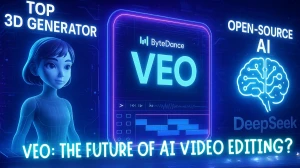Google DeepMind Genie 3: A 3D World Model Building AI Like Humans
Genie 3 from Google DeepMind is generating significant buzz in the machine learning research community at present. It’s not hype; the thing’s able to generate interactive digital worlds just from a sentence or a simple command, and you can actually walk around in the space—see and interact in real time, at up to 24 frames a second, 720p. In a recent update shared by @GoogleDeepMind on X, the company introduced Genie 3, its latest world model featuring real-time interaction. Unlike its predecessor, Genie 2, this new version brings enhanced realism and consistency, enabling the creation of dynamic 720p worlds at 24 frames per second.
That’s not a video or a pre-canned asset. It’s genuinely dynamic and kind of wild—both in visual fidelity and in how long it stays “consistent.” Earlier versions, like Genie 2, hit roadblocks. Environments would glitch or change details out of nowhere. But Genie 3 can remember things—say, you paint a wall and then explore for a bit. When you come back, the paint’s still there. Right now, though, only a small group of researchers and creators get to play with it. DeepMind is holding back public access, probably to get a handle on safety and misuse risks before wider rollout.
One of the most compelling reactions to Genie 3 came from X user @SincereMickey, who praised the model not just for its technical prowess but for its originality.
Some people are excited about its use in robotics, others are already war-gaming what it means for new kinds of smart environments. What’s impressive is the new “promptable world events” thing. You’re inside a generated world, but now you can type in changes—add weather, trigger objects, spawn characters. Aleksander Holynski, known on X as @holynski_, recently shared his excitement about #Genie3, describing it as a dynamic and playable experience that’s become a source of fun at the workplace.
It’s not just navigation; world conditions can morph, and Genie 3 handles the update so smoothly you almost forget it’s all synthetic. That’s big for any researcher thinking about robust, transfer-aware RL agents or multi-agent environments where control and stochastic events are key.
You get the sense that a lot of computer graphics folks didn’t expect this level of detail from pure data-driven generation. Most image models can’t keep visual details intact—objects disappear, morph, world breaks down. Here, Genie 3 keeps environments physically and visually grounded for a minute or even longer. That's legit progress and probably a real step forward for RL and world model research. You’re not getting perfect copy-paste reality.
The readable text inside Genie 3’s worlds, for example, usually only pops in if you put it there in your prompt—so not quite ready for, say, open-ended, multimodal dialogue agents running around solving puzzles with road signs or writing on the blackboard. Also, it’s invite-only for now. Access is being given to academics and a handful of creators, so don’t expect it on your dev box soon.
A lot of folks—me included—see Genie 3 as a sign that general-purpose “world models” are starting to mature in ways that could reshape how we build, analyze, and deploy intelligent systems. You can create scenarios for agents to learn navigation, memory, cause and effect, and more—all without relying on a prebuilt physical simulation or hand-crafted 3D assets.
For anyone working on agent-based learning, grounding, or transfer tasks, it’s hard not to be intrigued, or at least a little concerned about what’s coming next.






